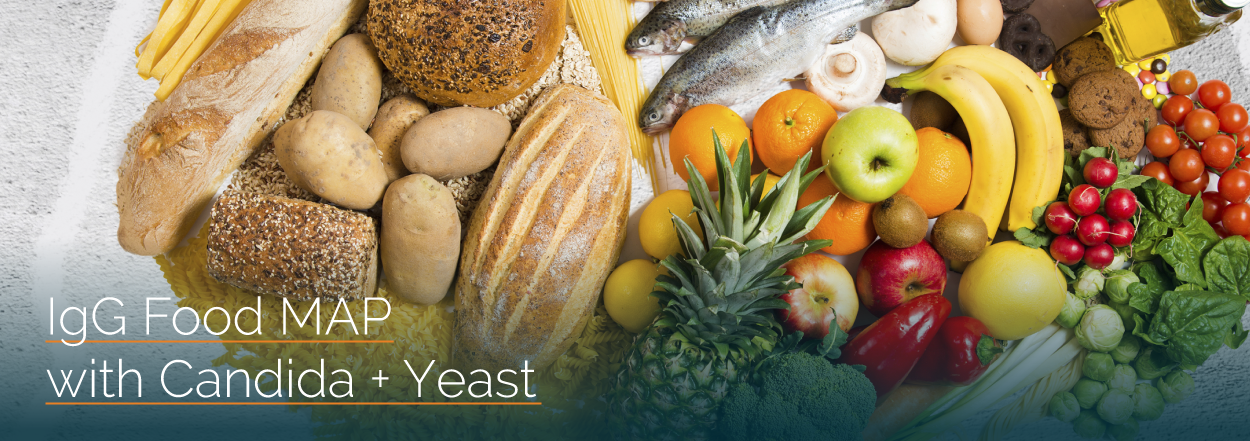Assesses 190 Foods
Includes a wide range of foods, common in the Western, Asian, and Mediterranean diets. We have added a hemp allergy marker because it is very common now as a food source or as medical CBD. We are able to run the IgG Food MAP on both serum and dried blood spot samples.
Upgraded Technology
Antigen-specific IgG antibodies are captured on multiplexed magnetic beads, using xMAP® (Multiple Analyte Profiling) technologies. The xMAP® bead-based immunoassay allows for the simultaneous detection of IgG antibodies to all 190 foods in two single test wells, reducing sample volume requirements and reagents while increasing sensitivity and specificity as compared to traditional plate-based ELISA tests. The upgraded immunoassay is cost and time effective, easy to perform and reproducible. We have now fully automated all steps of our testing processes, leading to even better precision.
Greater Reliability of Results
In the multiplexed bead-based immunoassay, food antigenic proteins are first covalently bound to beads. The beads are mixed with the patient’s sample where bead-bound antigens capture the specific IgG antibodies present in the sample. The food-specific IgG antibody level of each sample is detected with a
fluorescent-labelled antibody against IgG. Every reaction with a patient sample also contains control beads to ensure accurate results. The fluorescent signal is measured using an xMAP® analyzer. The amount of food-specific antibody detected per allergen-specific bead is directly proportional to the fluorescent signals. The higher the fluorescence, the more specific IgG antibodies are present in the sample. Once test results are available for review, our Quality Assurance (QA) team carefully verifies that quality control measures are within instrument and assay specifications.
Upgraded Sensitivity and Specificity
GPL’s xMAP® immunoassay with fluorescence readout has proven to be even more sensitive than ELISA tests. The IgG Food MAP test detects all food antibodies with greater precision than ELISA tests
thanks to the superior technology we’ve developed for the test.
Ecofriendly Technology
The xMAP® bead-based immunoassay is environmentally friendly, reducing plastic pollution. In the ELISA, a
panel for 190 foods would require 190 wells (2 plates) per sample. In contrast, the bead-based platform only requires two wells per sample.
In other words, the bead-based immunoassay would use just one plastic microtiter plate for testing 48 samples, while the ELISA would use 96 plates to test the same number of samples.
Tests for Specific Food Antigenic Proteins
GPL has upgraded from the ELISA’s single analyte detection to multiple analyte detection. The multiplexed, bead-based assay only detects IgGs against food antigenic proteins that were covalently bound
to the beads, making this assay more specific to proteins than the ELISA. In the ELISA, there is no covalent binding of proteins; instead, proteins or other antigens are bound to the surface of a plastic well by adsorption. This non- specificity of the surface allows the binding of glycan- rich molecules such as candida and yeast. Because of this, GPL is providing a separate report for the yeasts which will be tested by ELISA, rather than the xMAP® immunoassay.
What is IgG?
IgG is the major antibody found in serum. IgG’s are composed of two fragment antigen-binding (Fab) regions that contain the antigen-binding sites and the Fc region, which is responsible for most of the biologic activity of the antibodies (Figure 1). An antigen is a substance that causes the immune system to produce an antibody that specifically reacts with it. IgG-mediated reactions to food antigens may be delayed by several hours or days, whereas IgE food antibody reactions are quite immediate.
Significance of Total IgG Versus IgG4
The goal of IgG-mediated food allergy testing is to identify foods that are capable of triggering a large number of adverse reactions. IgG1, IgG2, and IgG3 are all capable of causing inflammation. IgG1, IgG2, and IgG3 antibodies to food antigens form large immune complexes or lattices that activate complement proteins and increase inflammation. IgG4 antibodies that are present with food antigens will not usually trigger inflammation, though high levels of these antibodies do indicate the presence of immune reactions against food antigens.
While most laboratories only provide a measurement of IgG4 molecules, The Great Plains Laboratory provides a measurement of total IgG antibodies to various food-based antigens and candida, a genus of yeast native to the GI tract. Testing for only IgG4 antibodies limits the ability of the clinician to identify those foods that may be causing significant clinical reactions in their patients. IgG4 antibodies usually represent less than 6% of the total IgG antibodies. The importance of measuring all subtypes of IgG antibodies is highlighted in an article by Kemeny et al. They found that IgG1 antibodies to gluten were elevated in all 20 patients with celiac disease but none of the patients had elevated IgG4 antibodies to gluten.
SPECIMEN REQUIREMENTS
The IgG Food Allergy Test is available as both Serum and Dried Blood Spot.
Serum: 1 mL of in a gold-topped SST or in a royal blue-topped no additive tube.
Dried Blood Spot (DBS): Four full circles of dried blood on the protein saver card is required.
Please note that the elimination of food prior to sampling will reduce the ability for our laboratory to detect antibodies (allergies) to that food.

